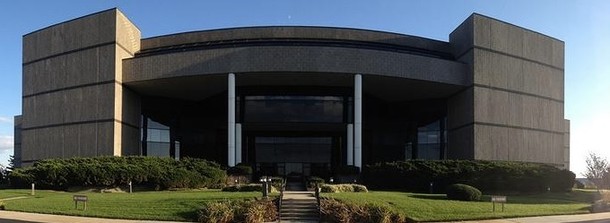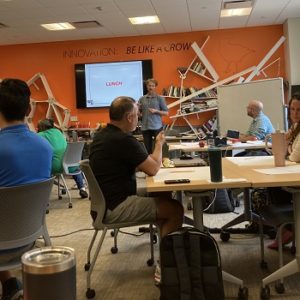At Lam Cloud Open House in Cranbury: Food, Thought and the Internet IS a Series of Tubes

Lam Cloud officially inaugurated its new business and continuity technology campus in Cranbury on Nov. 14, 2013 with an open house celebration featuring inspiring speakers, great food and a tour of the building.
The 495,000-square-foot facility – formerly Aetna’s headquarters – was completely revamped to accommodate up to 275,000 square feet of scalable colocation and enterprise SSAE 16– compliant, Tier 2/3 data center and 4,000 workplace recovery seats. The company thinks of the building as a technology campus and has included conference and lounge space in it.
“This is a place where businesses and technologies can come together and find each other a little easier,” Lawrence Lam, founder and CEO, said in his opening remarks.
“We wanted to [establish this facility] because a lot of businesses can’t find the technology they need easily. We thought it would make some sense for someone to come into the middle and help facilitate this,” he stated.
The focus of the day was business continuity: what happens when the unexpected happens, Lam said.
Lam Cloud offers space and data capabilities for companies that are affected by disaster, whether it’s something as great as Superstorm Sandy or something that only affects their own buildings, like a fire. The company is also considering offering business incubation space.
“We are about being strong in New Jersey,” Lam added. Lam Cloud is looking to help companies keep their businesses running at 100 percent through up-to-date networks, partnering and networking.
Apropos to the idea that a building can house both data and the physical equipment that makes the Internet work, Lam Cloud invited Andrew Blum, the author of Tubes, A Journey to the Center of the Internet, to speak at its open house.
In his book, Blum said, “the Internet is as fixed in real, physical places as any railroad or telephone system ever was. In basest terms, it is made of pulses of light. Those pulses might seem miraculous, but they’re not magic.”
“They are produced by powerful lasers contained in steel boxes housed mainly in unmarked buildings. The lasers exist. The boxes exist. The buildings exist. The Internet has a physical reality, an essential infrastructure, a ‘hard bottom,’ as Henry David Thoreau said of Walden Pond.”
Blum noted that, like most people, he used to think of the Internet in virtual terms. Things started to change for him when his Internet stopped working and he followed a cable repair person who was tracing the wire from behind his sofa to a clump of wires bolted to the building.
The repair person said, “I think a squirrel is chewing on your Internet.” That seemed preposterous to Blum, “since the Internet is supposed to be a transcendent idea. … Most people don’t think of [it as] something that a squirrel can chew on.”
Blum wanted to see where the Internet would go, and so he began the journey that is described in the book. “Very few people have a clear sense of how all the systems are connected together,” he said.
He added that his patron saint for the project was the late Sen. Ted Stevens, who famously said in 2006 that the Internet isn’t something you dump something on like a big truck. It is a series of tubes. Stevens was ridiculed for his remark, but Blum believes he was on the right track.
Blum started out by taking a photographer to capture a photo of a fiber regeneration hut in Kansas. The Internet, he said, runs “along old paths. It’s along railroad tracks, it’s along the Boston Post Road, it’s along Route 1. It’s not a new geography but follows routes that have been around for hundreds of years.”
The most important places in the Internet are the buildings where more pieces of the Internet connect to other pieces, such as 60 Hudson St. in New York City. It was a Western Union building built for the telegraph and also is a sister building to AT&T’s Long Lines building at 30 Avenue of the Americas, with the buildings connected.
“When you go to 60 Hudson you tell everyone you are there because you are there to interconnect,” Blum said.
“My favorite part of visiting these places was the fiber vault, the place where the fiber comes out of the ground … It smells like dirt because this is the place where the Internet connects to the earth,” he said.

